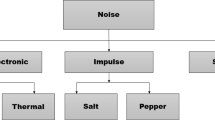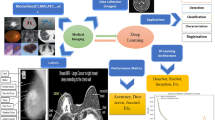Abstract
Magnetic resonance image (MRI) plays a crucial role in medical applications for visual analysis and processing. Rician noise which arises from the MRI during acquisition can affect the quality of the image. This crucial issue should be addressed by denoising method. The proposed adaptive rician noise removal based on the bilateral filter using fuzzy hexagonal membership function improves the denoising efficiency at various noise variances and preserves the fine structures and edges. The fuzzy weights were obtained with the local mean (μi) and global mean (μg) by constructing hexagonal membership function for local order filter and bilateral filter. Bilateral filter is used to preserve the edges by smoothening the noises in MRI image and local filter is used to preserve the edges and retrieve the structural information. Brain MRI images are restored by multiplying its corresponding fuzzy weight with the restored image of local order filter and bilateral filter. Experiments on synthetic and clinical Brain MRI data were done at different noise levels by the proposed method and the existing methods. The result shows that the proposed method restores the image in better visual quality and can be well utilized for the diagnostic purpose at both low and high densities of rician noise.







Similar content being viewed by others
References
Abazari R, Lakestani M (2017) Fourier based discrete Shearlet transform for speckle noise reduction in medical ultrasound images. Current Medical Imaging. https://doi.org/10.2174/157340561366617040515082
Abazari R, Lakestani M (2018) A hybrid denoising algorithm based on shearlet transform method and Yaroslavsky’s filter. Multimed Tools Appl. https://doi.org/10.1007/s11042-018-5648-7
Akar SA (2016) Determination of optimal parameters for bilateral filter in brain MR image denoising. Appl Soft Comput 43:87–96
Alhihi M, Khosravi MR (2018) Operating task redistribution in hyperconverged networks. International Journal of Electrical and Computer Engineering 8(3):1629–1635
Alhihi M, Khosravi MR (2018) Formulizing the fuzzy rule for Takagi-Sugeno approach in network traffic control. The Open Electrical & Electronic Engineering Journal 12(1):1–11
Alhihi M, Khosravi MR, Attar H, Samou M (2017) Determining the optimum number of paths for realization of multi-path routing in MPLS-TE networks. TELKOMNIKA 15(4):1701–1709
Anand CS, Sahambi JS (2010) Wavelet domain non-linear filtering for MRI denoising. Magn Reson Imaging 28:842–861
Ashburner J, Friston K (2000) Voxel-based morphometry – the methods. NeuroImage 11:805–821
Chen Y, Yang J, Zhang Y, Shu H et al (2016) Structure-adaptive fuzzy estimation for random-valued impulse noise suppression. IEEE Trans Circuits Syst Video Technol. https://doi.org/10.1109/TCSVT.2016.2615444
Dougherty G (2009) Digital image processing for medical applications. Cambridge University Press, Cambridge
Edelstein WA, Glover GH, Hardy CJ, Redington RW (1986) The intrinsic SNR in NMR imaging. Magn Reson Med 3(4):604–618
Gerig G, Kubler O, Kikinis R, Jolesz FA (1992) Nonlinear anisotropic filtering of MRI data. IEEE Trans Med Imaging 11(2):221–232
Henkelman RM (1985) Measurement of signal intensities in the presence of noise in mr images. Med Phys 12(2):232–233
http://www.insight-journal.org/midas/. Accessed 01 July 2017
Hu J, Zhou J, Wu X (2016) Non-local MRI denoising using random sampling. Magn Reson Imaging 34:990–999
Isik A, Firat D (2017) Bilateral intra-areolar polythelia. Breast J. https://doi.org/10.1111/tbj.12838
Justin J, Sivaraman J, Rajadurai P, Simiv R (2017) An edge preservation index for evaluating nonlinear spatial restoration in MR images. Current Medical Imaging 13(1):58–65
Kala R, Deepa P (2017) Adaptive hexagonal fuzzy hybrid filter for Rician noise removal in MRI images. Neural Comput & Applic 29(8):237–249
Kaur P, Singh G, Kaur P (2017) A review of Denoising medical images using machine learning approaches. Current Medical Imaging. https://doi.org/10.2174/1573405613666170428154156
Khan SU, Ullah N, Ahmed I, Chai WY, Khan A (2017) MRI images enhancement using genetic programming based hybrid noise removal filter approach. Current Medical Imaging. https://doi.org/10.2174/1573405613666170619093021
Khosravi MR, Akbarzadeh O, Salari SR, Samadi S, Rostami H (2017) An introduction to ENVI tools for synthetic aperture radar (SAR) image despeckling and quantitative comparison of denoising filters. In: IEEE international conference on power, control, signals and instrumentation engineering (ICPCSI), India
Khosravi MR, Basri H, Rostami H (2018) Efficient routing for dense UWSNs with high-speed Mobile nodes using spherical divisions. J Supercomput 74(2):696–716
Kumarganesh S, Suganthi M (2018) An enhanced medical diagnosis sustainable system for brain tumor detection and segmentation using ANFIS classifier. Current Medical Imaging 14(2):271–279
Lim JS (1990) Two-dimensional signal and image processing. Prentice Hall, Englewood Cliffs, pp 469–476
Lim JS (1990) Two-dimensional signal and image processing. Prentice Hall, Englewood Cliffs, p 548
Lujan HJ, Plasencia G, Rivera BX et al (2017) Advantages of robotic right colectomy with Intracorporeal anastomosis. Surg Laparosc Endosc Percutan Tech 28(1):36–41. https://doi.org/10.1097/sle.0000000000000384
Manjon JV, Carbonell-Caballero J, Lull JJ, Garcia-Marti G, Marti-Bonmati L, Robles M (2008) MRI denoising using non-local means. Med Image Anal 12:514–523
Misra D, Sarker S, Dhabal S, Ganguly A (2013) Effect of using genetic algorithm to de-noise MRI images corrupted with Rician noise. In: IEEE international conference on emerging trends in computing, communication and nanotechnology, Tirunelveli, India, pp 146–151
Nowak RD (1999) Wavelet-based Rician noise removal for magnetic resonance imaging. IEEE Trans Image Process 8(10):1408–1419
Perona P, Malik J (1990) Scale-space and edge detection using anisotropic diffusion. IEEE Trans Pattern Anal Mach Intell 12:629–639
Phophalia A, Mitra SK (2015) Rough set based bilateral filter design for denoising brain MR images. Appl Soft Comput. https://doi.org/10.1016/j.asoc.2015.04.005
Riji R, Jeny R, Jan S, Madhu NS (2015) Iterative bilateral filter for Rician noise reduction in MR images. Signal, Image and Video Processing 9(7):1543–1548
Samsonov AA, Johnson CR (2004) Noise-adaptive nonlinear diffusion filtering of MR images with spatially varying noise levels. Magn Reson Med 52:798–806
Sharif M, Hussain A, Jaffar MA, Choi T-S (2015) Fuzzy similarity based non local means filter for rician noise removal. Multimed Tools Appl 74(15):5533–5556
Sharif M, Hussain A, Jaffar MA, Choi T-S (2016) Fuzzy-based hybrid filter for rician noise removal. SIViP 10(2):215–224
Sudeep PV, Palanisamy P, Chandrasekharan K, Jeny R (2015) Nonlocal linear minimum mean square error methods for denoising MRI. Biomed Signal Process Control 20:125–134
Yingtao Z, Cheng HD, Huang J, Tang X (2012) An effective and objective criterion for evaluating the performance of denoising filters. Pattern Recogn 45:2743–2757
Zhang Y-D, Pan C, Sun J, Tang C (2018) Multiple sclerosis identification by convolutional neural network with drop out and parametric ReLU. J Comput Sci. https://doi.org/10.1016/j.jocs.2018.07.03
Acknowledgments
The authors are grateful for the financial support provided by University Grants Commission (UGC) under Rajiv Gandhi National Fellowship, New Delhi, India. Grant number: F1-17.1/2016-17/RGNF-2015-17-SC-TAM-23661.
Author information
Authors and Affiliations
Corresponding author
Ethics declarations
Conflict of interest
There is no conflict of interest.
Additional information
Publisher’s note
Springer Nature remains neutral with regard to jurisdictional claims in published maps and institutional affiliations.
Rights and permissions
About this article
Cite this article
Kala R, Deepa P Adaptive fuzzy hexagonal bilateral filter for brain MRI denoising. Multimed Tools Appl 79, 15513–15530 (2020). https://doi.org/10.1007/s11042-019-7459-x
Received:
Revised:
Accepted:
Published:
Issue Date:
DOI: https://doi.org/10.1007/s11042-019-7459-x




